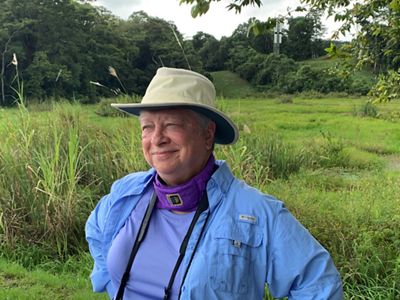

From the Director
Dear Friends,
I hope the cover images of our 2025 annual report are as resonant for you as they are for me. The family of oystercatchers on the front are feisty, but so fragile, fully dependent on protected habitats to sustain them. On the back, a visitor enjoys an accessible trail, soaking in the many proven health benefits of being outdoors. The important chord being struck? The photos were taken at the same place: The Nature Conservancy’s South Cape May Meadows preserve, where wildlife and people thrive side by side.
The same harmony is achievable not just locally, but also on a much wider scale around the globe—if we thoughtfully commit to integrating nature into our plans and actions. It means moving forward with bold goals, innovative projects and a tenacious approach to protect and restore our lands, waters, coasts and cities.
The Nature Conservancy’s team in New Jersey is already “on it,” with a smart, science-based strategic plan in place for 2030 that prioritizes critical landscapes and natural resources for communities, both human and wild.
You are empowering us to make meaningful progress by supporting that plan and its essential 2030 objectives, including the accomplishments featured in this report. THANK YOU. Together, we protected land in Bobcat Alley, New Jersey’s corner of the Appalachians, which is of outsized importance for habitat connectivity on the North American continent. We removed outdated dams from major Delaware River tributaries, freeing passage for fish and improving the quality of our drinking water sources.
At the Jersey Shore, we demonstrated the importance and success of keeping sediment in our coastal salt marsh systems, garnering unprecedented advocacy from state agencies for scaling up a beneficial, nature-based restoration technique. In Newark and Paterson, we continued supporting community efforts to combat excessive heat and flooding with the humblest of solutions—trees!—while at our five flagship preserves, we marked completion of enhancements that allow more people to experience delight in nature.
It is impressive, but guess what? We are just getting started! As we reflect on the past year’s wins, let us simultaneously reinvigorate our pledge to accelerate conservation momentum. Our world in New Jersey and across the planet depends upon it now and for the future.
Please join us in celebrating this year’s achievements and in reaffirming unwavering dedication to nature through philanthropy and action. Together, we find a way!
Yours in conservation,
Dr. Barbara Brummer
2025 Annual Report
Explore how we worked to protect nature and safeguard biodiversity in 2025. From restoring habitats to advancing climate solutions, see the impact your support made possible.


Stay connected for the latest news from nature.
Get global conservation stories, news and local opportunities near you. Check out a sample Nature News email.

Lands
Wildlife Wins in Trenton
Wildlife must be able to move safely through New Jersey’s landscape to find food, shelter and mates. Roadways and development in our small, densely populated state pose a significant hindrance, increasingly isolating animals in fragmented habitats. TNC’s policy team drafted and advocated for passage of New Jersey’s first-ever Wildlife Corridor Action Plan and celebrated the bill being signed into law this year with overwhelming bipartisan support. The plan will:
- Identify wildlife corridors and barriers to wildlife passage across New Jersey
- Improve wildlife crossings through use of overpasses, culverts and other enhancements
- Increase road safety by reducing wildlife-vehicle collisions
This initiative will align with existing conservation efforts such as the State Wildlife Action Plan and Connecting Habitats Across New Jersey while also encouraging the NJ Department of Transportation to factor wildlife considerations into road development. Shoutout to the Trustees on our Conservation Committee who, along with TNC Government Relations staff, traveled to Trenton to make their voices heard in support of this important legislation!

Preserves
Prioritizing People and Nature
South Cape May Meadows, our most visited flagship preserve, annually welcomes tens of thousands of people and innumerable birds and wildlife species. We continue to make site improvements to support these VIP guests.
For our human visitors, we have fully completed the half-mile, ADA-compliant boardwalk and recently added enhancements including a new parking lot with paved, accessible spaces and a convenient hydration station where visitors can refill water bottles or drink from a fountain. The upgrades are already spurring use by a local nursing home and a service organization for people with disabilities.
Beach-nesting birds have also benefited from our efforts. A seasonal exclosure with extensive fencing, decoys and audio deterrents provides sensitive shorebirds with predator-protected space to raise their young.
And—new this year—we elevated five acres of sand and shell beds by almost three feet so nests have a better chance of staying out of floodwaters during storms.
Results on all fronts are encouraging. We recorded more than 69,000 people visiting the preserve in the last year, including some at TNC-hosted outings like Mindful Birding and The Little Sit. And our beach successfully fledged two American oystercatcher chicks and the highest number of least terns (80!) in New Jersey for the second year in a row.

Rivers
They’re Free…Free Flowin’
Meeting our 2030 goal to reconnect 500 miles of New Jersey rivers by removing 50 outdated and obsolete dams will take teamwork across many stakeholders. In the last three years, the TNC-led Statewide Dam Removal Partnership has offered in-person trainings and informational webinars for 600 unique participants—some far beyond our state’s borders.
TNC also completed the third round of a Dam Removal Small Grants program in fall 2024. We awarded five grants totaling $150,000 to help county, municipal and nonprofit partners advance various stages of dam removal, including monitoring, engineering design, permitting and construction. The funding and technical assistance we provide is supporting dam removals in the Raritan, Musconetcong and Rockaway rivers. The Oak Ridge Lake Dam on the Rockaway River will be the first dam to be fully removed with support from this program.
No Name Is No More!
TNC has eliminated two outdated barriers from the Pequest River! The Cedar Grove Dam and No Name Dam were both small and privately owned—ideal training projects for engineering and construction firms inexperienced in dam removal. By providing such companies with the opportunity, along with mentoring by experienced technical consultants, we not only removed the Pequest dams but built contractor capacity for similar projects in the state.

Coasts
Saving New Jersey's Salt Marshes
Salt marshes are dynamic habitats that change shape and migrate inland when faced with ecological challenges like erosion and excess inundation, but these natural processes are impossible on much of New Jersey’s heavily developed shoreline. TNC and partners have demonstrated an effective alternative: intervening to increase marsh elevation proportionally to the rising waters around them.
Our pilot projects with partners to restore marshes in Avalon and Fortescue using dredged sediment from clogged boating channels resulted in full revegetation of the sites within seven years. Building on that success, TNC has made strides in mainstreaming this sensible marsh nourishment approach.
At the request of the NJ Department of Transportation Office of Maritime Resources, our staff completed New Jersey’s first Regional Sediment Management Framework for the Atlantic Back Bays. This resource provides comprehensive guidance for agencies and stakeholders to put dredged sediment to beneficial use on salt marshes, including policy, coordination and planning, environmental management, regulation and permitting, research and technology, and cost and financing.

Cities
Growing the Newark Tree Canopy Initiative
Cities share many environmental challenges, like extreme heat, poor air quality, stormwater runoff and flooding, and New Jersey’s urban centers are no exception. Newark has the second-highest heat island effect in the country, so planting temperature-reducing trees to increase canopy cover is paramount for community leadership. In Paterson, flooding is the top environmental problem, and efforts are focused on ways to use green, nature-based solutions to help capture stormwater runoff and reduce flooding.
Earlier this year, TNC joined 10 partners in officially kicking off the five-year Newark Tree Canopy Initiative to develop an urban forestry master plan for Newark, plant more than 3,000 trees and engage 200 residents in a paid workforce development training in urban forestry and tree stewardship. TNC secured an $8 million grant from the U.S. Forest Service and is finalizing agreements with partners and the City of Newark to outline roles, responsibilities and funding for this major initiative.
This spring, TNC and partners began surveying potential planting sites in the city’s rights of way, identifying approximately 160 suitable locations so far. We are working with community-based partner organizations and Rutgers University to develop the curriculum for the Workforce Development Training Program. Within the year, we will launch the first cohort of the workforce training and plant at least 600 new trees in the city.




